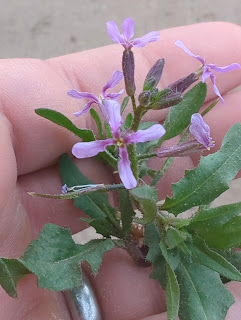"Yellow is the sun, the giver of life; green is the hope, the promise of what will be." - Oscar Wilde
Spring is a season of vivid colors. In Corrales the stark black and white of winter is sloughed off to be replaced with bright yellow flowers, red catkins, green leaves, and blue skies. While there is change in all seasons, the differentiation between spring and summer is the most stark. There is change as bird and insect migrations happen and new forms appear. Human work their changes upon the soil and animals start preparing for the breeding season.
There are yellow and red catkins all over the ground right now. These are wind pollinated flowers that appear just as the windy season is peaking from the unstable air vortices that form off the jetstream north of New Mexico. Catkins are specialized structures for pollination common in early spring and in areas with sparse trees.
Coopers's hawks have adjusted to living near to bird feeders and thrive on the abundant mourning doves. They ambush in thick cover and the smaller males are often heard calling warnings near to where a female is nest building. They have a distinctive long, banded tail.
While the basic needs of all animals remains the same; food, shelter, and stimulation, the focus will change. Shelter from cold becomes shelter for young. Minimum calories becomes extra calories for egg production as well. Activity increases along with anxiety. This pile of feathers shows where a cooper's hawk caught a young dove.
Plant reproduction gets really complex quickly but is a very interesting subject. How a pollen grain gets to an ovary is a simple, yet very nuanced process. The complexity seems to be necessary to allow an organism to be in tune with its surroundings, be that wind, insects, the host plant, or other plants nearby. Domestication has it's own way of messing with the course of things. I think this a cherry blossom. The blossom is only out for a short time, is easily damaged and dependent on cultivated bee hives that collect pollen, rather than nectar.The science of honeybees is rather dense, but has also become more specialized in commercial orchards.
Mistletoe is an interesting plant for many reasons. First, it is dioecious, meaning different plants are different sexes. The flowers we see in storybooks, like roses or tulips, are "perfect" meaning stamens and pistils are found on the same plant. Another odd fact is that young mistletoe plants have circumnutation action. This means they rotate their center as they grow, and it is not controlled by any external stimulus. It's one reason scientists sent fast growing seedlings into space to grow. The nectar of the flower is apparently orange scented, attracting many species of fly, gnat and wasps.
Tymmetry of flowers is a common reason people appreciate them. This is the common cross flower. Many of these small plants can be found on East Ella outside the senior center building. It has a smell considered by some agreeable (melted crayons) or disagreeable (stale dish rags, mushroom-y) it is another edible winter annual like the more common wild mustard species.
Still trying to figure out this common plant. There are many species that thrive in spite of our ever present war against all things green. The ones that are good at it get to be called weeds.
Many plants people encourage, like this alfalfa. It is grown to save money on winter forage for horses in Corrales. The shoots can often be found on ditch banks near to irrigated fields. This crop grows well in the arid southwest as long as there is good irrigation available. It can be cut from four to seven times a year.
We have a windy season that works very well for wind pollinated plants like pines. the elms also use the summer winds and occasional humidity to release their samsaras. They are not leaves, but seed casing, that taste a lot like snap peas when they are green. in early summer they will rival the cottonwood seed blizzards that follow. Right now the winds are blowing down those that are not quite ready.
Globe willows, like this plant put out jaw dropping amounts of pollen into the unsettled air, but their beautiful yellow canopies compete with the pinks and whites of other cultivated trees. However they then have to shed all those caterpillar catkins, raising the ire of neighbors not well disposed to "litter". There is a thriving market for trees that don't produce flowers, or fruit that can be dropped on driveways, for a price, of course. A simple way is to sell trees that are only male, but they have issues with pollen allergens. It's a complicated world out there.
These are the seedlings of the infamous Russian thistle that spread across the US from South Dakota in 1873. They thrive on loose, dry and windblown soil. Conditions are perfect now for the small seedligs to grow quickly.
The bosque has a wide variety of ecosystems nestled inside its boundaries, like nesting dolls. Areas of bright sun are opened up by human trails which allow the grass light and water in the areas dominated by Russian olive.
Salt cedar trees control their environment with their spiny shed leaves. These leaves accumulate salt, and when they are shed the salinity kills off any young sprouts nearby by salt stress.
The roots of trees harbor a variety of organisms in an ecosystem. This is termed the rhizosphere and includes microscopic worms and insects. These little holes are where some sort of root boring beetle has emerged into the surface world to pupate and mate.
Heavy equipment often damages the surface of the soil, denuding it and preventing runoff from soaking into the soil and being held by various acids. The scars of machine clearing can take many years to become unnoticed again.




























No comments:
Post a Comment